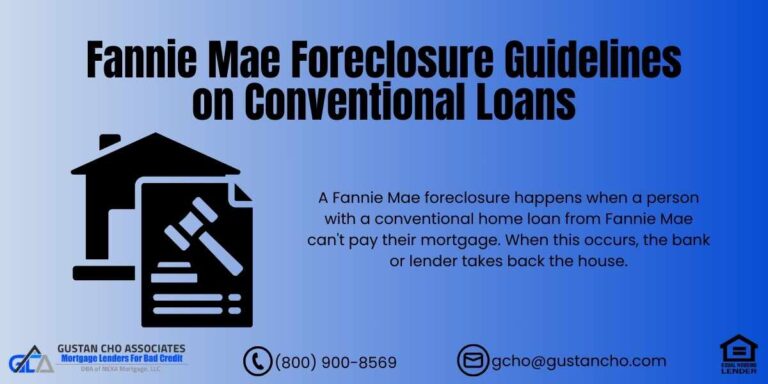Mortgage After Bankruptcy and Foreclosure Guidelines
In this blog, we will cover getting qualified for a mortgage after bankruptcy and foreclosure. Homebuyers can qualify for a mortgage after bankruptcy, foreclosure, or a housing event. A housing event is a foreclosure, a deed in lieu of foreclosure, or a short sale. You can qualify for a government and/or conventional loan after bankruptcy and/or foreclosure with zero percent to a maximum of a 5% down payment. Dale Elenteny, a senior loan officer of Mortgage Lenders for Bad Credit, says the following:
Government and conventional loans require mandatory waiting period requirements after bankruptcy, foreclosure, deed in lieu of foreclosure, and short sale. Mortgage Lenders for Bad Credit has wholesale lending partners that offer non-QM mortgages one day out of foreclosure and/or bankruptcy.
However, a 30% down payment is required on non-QM loans one day out of foreclosure and/or bankruptcy. The longer the bankruptcy and/or housing event season, the lower the down payment requirement. Qualifying for a mortgage after bankruptcy and foreclosure is not a problem. However, just meeting the waiting period requirement does not guarantee an automatic mortgage loan approval.
Rebuilding Credit To Get a Mortgage After Bankruptcy and Foreclosure
Lenders expect borrowers to have rebuilt and reestablished credit after bankruptcy and/or a housing event. No late payments after bankruptcy, foreclosure, deed in lieu of foreclosure, or short sale. Borrowers with late payments after bankruptcy and foreclosure or a housing event are considered second offenders.
Most lenders will have lender overlays on late payments after bankruptcy and/or a housing event and want nothing to do with them. However, one or two late payments are not always deal killers at Mortgage Lenders For Bad Credit.
As long as you can get approved/eligible per the automated underwriting system (AUS), Mortgage Lenders for Bad Credit can do your loan. Mortgage Lenders for Bad Credit have no lender overlays on government and conventional loans.
Get a Mortgage After Bankruptcy or Foreclosure
Apply Now And Get recommendations From Loan Experts
Mortgage After Bankruptcy and foreclosure With No Waiting Period Requirements
Many Americans are still under the belief that filing bankruptcy will be the kiss of death when it comes to qualifying for a home loan. Other Americans think they can no longer get credit after bankruptcy. This is not true. Bankruptcy is a federal law that helps Americans drowning in debt get a fresh financial start in life. Bankruptcy has no negative impact on loan-level pricing adjustments on mortgage rates. Many who file bankruptcy can get a 700 credit score less than one year after the bankruptcy discharge date. The team at Mortgage Lenders for Bad Credit is helping homebuyers qualify for a mortgage after bankruptcy.
There are no waiting period requirements on qualifying for a mortgage after bankruptcy with non-QM loans. Last year, more than 789,222 consumers filed for personal bankruptcy. Every one of the people who filed for bankruptcy will be able to qualify for a mortgage. As soon as the bankruptcy is filed, consumer credit scores will drop anywhere between 100 to 200 points.
Bankruptcy does devastate your credit score, usually causing it to fall by 200 or more points. However, this sudden drop is temporary. The team at Gustan Cho Associates has helped countless borrowers get their credit scores to over 700 FICO in just one year after the bankruptcy discharge date. As the bankruptcy ages, it will have less of an impact on credit scores. Chapter 13: Bankruptcy remains on credit reports for 7 years. Chapter 7: Bankruptcy remains on a credit report for 10 years.
Qualifying For A Mortgage After Bankruptcy and foreclosure: Types Of Bankruptcy
In this article, we will discuss and cover the two most popular consumer bankruptcies in the United States. Chapter 7 and Chapter 13: Bankruptcy. Dale Elenteny, a senior mortgage loan originator at Mortgage Lenders for Bad Credit explains the waiting period guidelines after bankruptcy as follows:
Every home mortgage program has different waiting period requirements after bankruptcy in order to be eligible to qualify for a home loan. Non-QM mortgages one day out of bankruptcy do not have a mandatory waiting period requirement but do require a 30% down payment.
Chapter 7: Bankruptcy is the most common type of bankruptcy among consumers. Chapter 7 Bankruptcy benefits borrowers without a job and/or irregular income, little to no assets, and those with unsecured debts.
Benefits of Filing Bankruptcy
Most debts, such as collections, charged-off accounts, judgments, and other unsecured debts, can be discharged in Chapter 7 bankruptcy. Chapter 7 bankruptcy is discharged in 90 days from the date you file. Government debts such as federal tax liens, court fines, and debts incurred due to fraud are not dischargeable in bankruptcy. Please consult your bankruptcy attorney for more details.
How Does Chapter 13 Bankruptcy Work?
Chapter 13 Bankruptcy is for consumers with a steady income and those who have assets. Chapter 13 Bankruptcy is called restructuring and/or reorganization bankruptcy. Angie Torres of Gustan Cho Associates explains to whom consumers pay debts during the Chapter 13 bankruptcy repayment plan as follows:
A percentage of the petitioner’s monthly income is allocated to pay creditors. Most Chapter 13 Bankruptcy is for a 60-month payment plan.
After the petitioner satisfactorily makes monthly, timely payments to creditors for the term of Chapter 13 bankruptcy, the balance of the debts is discharged. Once bankruptcy is discharged, the consumer is debt-free and can restart rebuilding and reestablishing their credit.
Qualifying For A Mortgage After Bankruptcy and foreclosure
Apply Now And Get recommendations From Loan Experts
Qualifying For A Mortgage Bankruptcy and foreclosure Depends On The Type Of Loan Program
Borrowers can qualify for an FHA and VA loan during the Chapter 13 bankruptcy repayment plan. Chapter 13 Bankruptcy discharge does not have to be discharged. However, you need to be on the repayment plan for a period of at least 12 months. 12 months of timely payments to the bankruptcy trustee as well as trustee approval.
How Chapter 13 Bankruptcy Mortgage Process Work
Bankruptcy Trustees will sign off on a home mortgage. Mortgage Lenders for Bad Credit never had a situation where a Chapter 13 bankruptcy trustee did not sign off on a home mortgage. The file needs to be manual underwriting. Manual underwriting guidelines apply.
There is no waiting period after the Chapter 13 Bankruptcy discharge date to qualify for an FHA and/or VA loan.
If Chapter 13 bankruptcy has not been seasoned for at least two years, it needs to be manually underwritten.
What Are The Waiting Period Requirements After Bankruptcy
There is a four-year waiting period after the Chapter 7 bankruptcy discharge date to qualify for conventional loans. There is a two-year waiting period after the Chapter 13 bankruptcy discharge date to qualify for conventional loans. There is a four-year waiting period after the Chapter 13 bankruptcy dismissal date to qualify for conventional loans.
Non-QM loans has no waiting period to qualify for a home mortgage after foreclosure and bankruptcy. However, non-QM loans require a 20% to 30% down payment.
There is a two-year waiting period after the Chapter 7 bankruptcy discharge date and three years after foreclosure, deed in lieu of foreclosure, and short sale to qualify for FHA loans. There is a two-year waiting period after Chapter 7 bankruptcy, foreclosure, deed in lieu of foreclosure, or short sale to qualify for a VA loan. There is a three-year waiting period after the Chapter 7 bankruptcy discharged date, foreclosure, deed in lieu of foreclosure, or short sale to qualify for a USDA loan.
Mortgage Included in Bankruptcy
If you had a prior mortgage included in a bankruptcy, there is a four-year waiting period after the bankruptcy discharge date to qualify for a conventional loan.
The date of the foreclosure, the deed in lieu of foreclosure, or a short sale does not matter. However, you cannot reaffirm your mortgage after bankruptcy.
Non-QM mortgages one day out of bankruptcy and/or foreclosure have no mandatory waiting period required to qualify for a home loan. However, it does require a 30% down payment.
Rebuilding And Reestablishing Credit After Bankruptcy and Foreclosure
Just passing the waiting period after bankruptcy does not automatically make you eligible to qualify for a home mortgage. You need to have re-established credit after bankruptcy. Eric Jeanette said the following about rebuilding credit after foreclosure and bankruptcy:
Getting three to five secured credit cards is the easiest and fastest way of rebuilding and re-establishing credit after bankruptcy. Getting one or two installment loans will add to rebuilding and re-establishing credit after bankruptcy. You do not need to hire a credit repair service.
Credit Repair To Qualify For Mortgage After Bankruptcy and Foreclosure
Credit repair will often do more damage than good during the home mortgage process. Credit disputes are not allowed during the mortgage process. All non-medical, non-exempt credit disputes need to be removed in order for the mortgage process to proceed. Retracting credit disputes will and can often plummet credit scores. This is because whenever consumers dispute a credit tradeline, the credit bureaus automatically negate the negative factoring from the credit scoring formula.
Therefore, if consumers dispute bad credit, their credit scores will go up. This is because the credit scoring model will discount the bad credit from the credit scoring formula and the consumer credit scores will go up.
However, when they retract credit disputes, the credit scores can drop significantly because the bad credit will report back on the credit report and credit scoring formula as a new derogatory credit account. Non-medical collections are exempt from retraction. Non-medical collections with zero outstanding balances are exempt. All non-medical collection accounts that total less than $1,000 are exempt from retraction. Any credit disputes that are older than 24 months from the date of the last activity are exempt from the exemption of credit disputes.
FHA, VA, and Non-QM Loan Options Available
Apply Now And Get recommendations From Loan Experts







